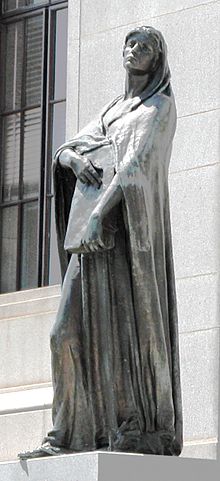| Veritas | |
|---|---|
Goddess of truth | |
 Veritas depicted on the tomb of Pope Alexander VII | |
| Symbols | nudity |
| Gender | female |
| Offspring | Virtus |
| Equivalents | |
| Greek | Aletheia (debated) |

Veritas is the name given to the Roman virtue of truthfulness, which was considered one of the main virtues any good Roman should possess. The Greek goddess of truth is Aletheia (Ancient Greek: Ἀλήθεια). The German philosopher Martin Heidegger argues that the truth represented by aletheia (which essentially means "unconcealment") is different from that represented by veritas, which is linked to a Roman understanding of rightness and finally to a Nietzschean sense of justice and a will to power.[1]
In Roman mythology, Veritas (Classical Latin: [ˈweː.rɪ.t̪aːs]), meaning Truth, is the Goddess of Truth, a daughter of Saturn (called Cronus by the Greeks, the Titan of Time, perhaps first by Plutarch), and the mother of Virtus. She is also sometimes considered the daughter of Jupiter (called Zeus by the Greeks),[2] or a creation of Prometheus.[3][4] The elusive goddess is said to have hidden in the bottom of a holy well.[5] She is depicted both as a virgin dressed in white and as the "naked truth" (nuda veritas) holding a hand mirror.[6][7][8]
In Western culture, the word may also serve as a motto.
- ^ B. Dallery, Arleen; E. Scott, Charles; Roberts, P. Holley (1992). Ethics and Danger: Essays on Heidegger and Continental Thought Issue 17 of Selected studies in phenomenology and existential philosophy. SUNY Press. p. 72. ISBN 9780791409831. Retrieved 4 October 2017.
- ^ Pindar Olympian Ode 10: But come, Muse, you and the daughter of Zeus, unforgettable Truth: with the hand that puts things right, keep from me the blame for lying, for wronging my friend. Approaching from far away, the future has arrived and made me ashamed of my deep debt. Still, payment with interest has a way of dissolving the bitter reproach of men.[1]
- ^ Aesop Fables 530 (from Phaedrus Appendix 5): Prometheus, that potter who gave shape to our new generation, decided one day to sculpt a statue of Truth, using all his skill so that she would be able to regulate people's behaviour. As he was working, an unexpected summons from mighty Jupiter called him away. Prometheus left cunning Trickery in charge of his workshop (Trickery had recently become one of the god's apprentices). Fired by ambition, Trickery used the time at his disposal to fashion with his sly fingers a figure of the same size and appearance as Truth with identical features. When he had almost completed the piece, which was truly remarkable, he ran out of clay to use for her feet. The master returned, so Trickery quickly sat down in his seat, quaking with fear. Prometheus was amazed at the similarity of the two statues and wanted it to seem as if all the credit were due to his own skill. Therefore, he put both statues in the kiln and when they had been thoroughly baked, he infused them both with life: sacred Truth walked with measured steps, while her unfinished twin stood stuck in her tracks. That forgery, that product of subterfuge, thus acquired the name of Falsehood, and I readily agree with people who say that she has no feet: every once in a while something that is false can start off successfully, but with time the Truth is sure to prevail.[2]
- ^ Macey, Samuel L. (2010). Patriarchs of Time: Dualism in Saturn-Cronus, Father Time, the Watchmaker God, and Father Christmas. University of Georgia Press. pp. 34–36. ISBN 9780820337975. Retrieved 4 October 2017.
- ^ This aphorism is attributed Democritus: "Of truth we know nothing, for truth is in a well." (Diogenes Laertius. Lives of Eminent Philosophers. IX, 72. Perseus Project, Tufts University.)
- ^ Mercatante, Anthony S. The Facts on File Encyclopedia of World Mythology and Legend. Facts on File, 1988, p. 654, ISBN 0-8160-1049-8.
- ^ Warner, Marina (1985). Monuments and Maidens: The Allegory of the Female Form. Berkeley: University of California Press. p. 315. ISBN 0520227336.
- ^ Goscilo, Helena (June 1, 2010). "The Mirror in Art: Vanitas, Veritas, and Vision". Studies in 20th & 21st Century Literature. 34 (2): 282–319. doi:10.4148/2334-4415.1733. Retrieved 2018-09-26.